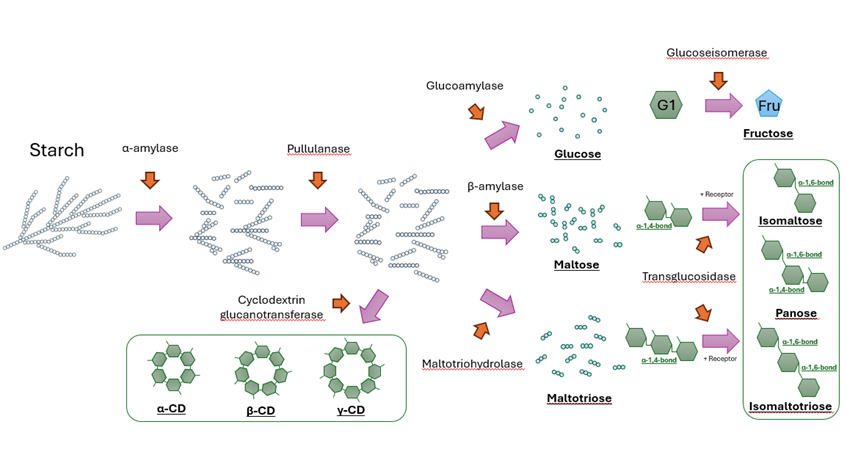What are Amylases?
Amylases represent a crucial class of specialized enzymes that catalyze the breakdown of starch molecules into simpler sugars through sophisticated biochemical processes. These remarkable biological catalysts serve as the foundation for converting complex carbohydrates into manageable, usable forms across numerous industrial applications.
From the moment food enters our mouths, where salivary amylases begin the digestive process, to large-scale industrial facilities producing everything from high-fructose corn syrup to bioethanol, these enzymes demonstrate their versatility and essential role in both biological systems and commercial applications. Their ability to precisely target and cleave specific chemical bonds makes them indispensable tools for manufacturers seeking efficient, sustainable processing solutions.
The significance of amylases extends far beyond simple starch breakdown. These enzymes enable the transformation of abundant, renewable starch resources into high-value products, supporting industries ranging from food and beverage manufacturing to pharmaceutical production and environmental biotechnology. Understanding their mechanisms and applications provides insight into one of biotechnology’s most successful commercial enzyme families.
Why Amylase Matters?
Market Significance
Amylases constitute approximately 25% of the global enzyme market, making them among the most important biological catalysts in industrial applications today. This market dominance reflects their versatility and essential role across multiple industries.
The economic impact of amylases extends across diverse sectors, enabling manufacturers to convert abundant, renewable starch materials into high-value products with remarkable efficiency. These enzymes facilitate the transformation of agricultural commodities such as corn, wheat, rice, and potatoes into essential industrial feedstocks and consumer products.
In baking applications, alpha-amylase enzymes have revolutionized modern bakery manufacturing processes through their ability to enhance dough handling properties, improve final product texture, and significantly extend shelf life. These enzymes work by strategically breaking down starch during the baking process, creating fermentable sugars that feed yeast and contribute to superior product quality and consistency.
The biological significance of amylases is equally compelling. Human digestive systems rely on these enzymes to initiate starch digestion in the mouth through salivary amylases and continue the process in the small intestine through pancreatic amylases. This dual-phase approach demonstrates the evolutionary importance of efficient carbohydrate processing for human nutrition and energy metabolism.
Beyond their traditional applications, amylases are increasingly important in sustainable technology development. Their role in biofuel production, biodegradable plastic manufacturing, and waste treatment processes positions them as key enablers of the circular economy and environmental sustainability initiatives across industries.
Key Principles of Amylases
Amylases operate through the fundamental biochemical process of hydrolysis, systematically adding water molecules to break the glycosidic bonds that hold starch polymers together. This sophisticated mechanism enables the controlled conversion of complex carbohydrate structures into simpler, more manageable sugar units.
Enzymatic Mechanism and Substrate Recognition
The catalytic process begins when the enzyme’s highly specific active site recognizes and binds to its starch substrate. This binding event triggers precise conformational changes in the enzyme structure, positioning catalytic residues optimally for bond cleavage. The enzyme-substrate complex formation is followed by the nucleophilic attack on the glycosidic bond, facilitated by carefully positioned amino acid residues within the active site.
Environmental Factors and Optimization
Temperature and pH conditions significantly influence amylase activity and stability. Most industrial amylases demonstrate optimal performance at temperatures ranging from 60-90°C and pH levels between 5.5 and 7.0, though specific optima vary among different enzyme variants. Research conducted at institutions such as UC Berkeley’s enzyme catalysis research continues to advance our understanding of these critical parameters.
Thermostable α-amylases have been extensively utilized in industrial applications for decades, but contemporary research focuses on engineering enhanced variants with superior stability characteristics, broader pH tolerance ranges, and improved catalytic efficiency for modern biotechnological processes. These advances enable more robust performance under challenging industrial conditions.
Substrate Specificity and Process Control
The inherent substrate specificity of different amylase types allows manufacturers to exercise precise control over starch breakdown patterns, enabling the production of specific product profiles tailored to particular applications. This selectivity is crucial for achieving consistent quality and meeting exact specifications in commercial production processes.
Industrial Applications
The versatility of amylases has established them as indispensable catalysts across numerous industrial sectors, where they enable efficient processing, improve product quality, and support sustainable manufacturing practices. Their applications span from traditional food processing to cutting-edge biotechnology applications.
Food and Beverage Industry
In food processing applications, amylases serve multiple critical functions that enhance both product quality and manufacturing efficiency. These enzymes are utilized in FDA-approved enzyme preparations for various food applications, ensuring safety and regulatory compliance.
Brewing operations rely heavily on amylases to convert grain starches into fermentable sugars, enabling alcohol production while controlling the final product’s sweetness profile and alcohol content. The precise control over starch conversion allows brewers to create distinctive flavor profiles and achieve consistent product characteristics across batches.
Corn syrup and high-fructose corn syrup production represents one of the largest industrial applications of amylases. These processes utilize sequential enzymatic treatments to achieve complete starch conversion, producing sweeteners that serve as essential ingredients in countless food and beverage products worldwide.
Textile and Paper Industries
Textile manufacturing processes employ amylases for desizing operations, where they remove starch-based sizing agents applied during weaving. This enzymatic approach offers environmental advantages over traditional chemical desizing methods, reducing water consumption and eliminating harsh chemical residues.
Paper production utilizes amylases to modify starch-based coatings and adhesives, improving paper surface properties and print quality. The enzymes enable precise control over coating viscosity and adhesion characteristics, contributing to enhanced product performance and manufacturing efficiency.
Specialized Applications
Food ingredients manufacturers increasingly employ amylases to produce prebiotic fibers and functional food components, contributing to the rapidly growing market for health-promoting products. These applications leverage the enzyme’s ability to create specific oligosaccharide structures with beneficial physiological properties.
Detergent formulations incorporate amylases to enhance stain removal capabilities, particularly for starch-based soils commonly found in food stains. The enzymatic approach provides superior cleaning performance at lower temperatures, supporting energy-efficient washing processes and environmental sustainability goals.
The Role of Amylase in Non-Dairy Drinks
The rapidly expanding non-dairy beverage market increasingly relies on sophisticated amylase applications to control sugar profiles, enhance nutritional content, and create complex carbohydrate structures that improve product functionality and consumer appeal.
Plant-based milk alternatives utilize carefully selected amylases to break down starches naturally present in oats, rice, and various grains, creating desired sweetness levels without requiring added sugars. This enzymatic approach enables manufacturers to produce clean-label products that meet growing consumer demand for natural, minimally processed alternatives to dairy milk.
The enzymatic conversion process allows precise control over the degree of starch breakdown, enabling manufacturers to achieve specific sweetness levels, viscosity characteristics, and nutritional profiles. This flexibility is particularly valuable in creating products tailored to different market segments and dietary requirements.
Advanced applications include the production of low-glycemic beverages, where controlled amylase treatment creates complex carbohydrates that provide sustained energy release. These products appeal to health-conscious consumers seeking alternatives to high-sugar beverages while maintaining desirable taste and texture characteristics.
Types of Amylases
Understanding the distinct characteristics and applications of different amylase types is essential for optimizing industrial processes and achieving desired product specifications. Each enzyme type offers unique capabilities that make them suitable for specific applications and processing conditions.
Alpha-Amylases
Alpha-amylases represent the most widely used amylase type in industrial applications, characterized by their ability to cleave internal α-1,4-glycosidic bonds within starch molecules. This endo-acting mechanism creates shorter chain fragments of varying lengths, making them ideal for initial starch liquefaction processes and applications requiring rapid viscosity reduction.
Beta-Amylases
Beta-amylases operate through an exo-acting mechanism, systematically cleaving maltose units from the non-reducing ends of starch chains. This precise, sequential action makes them particularly valuable in brewing applications where controlled maltose production is essential for achieving specific fermentation characteristics and final product profiles.
Glucoamylases
Glucoamylases excel at achieving complete starch conversion by systematically cleaving glucose monomers from the non-reducing ends of starch chains. Their ability to hydrolyze both α-1,4 and α-1,6 bonds enables complete saccharification, making them indispensable for glucose syrup production and applications requiring maximum starch utilization.
Pullulanases
Pullulanases specifically target α-1,6-glycosidic bonds at branch points in starch molecules, working synergistically with other amylases to achieve complete starch degradation. Their debranching activity is crucial for accessing the full potential of branched starch substrates and maximizing conversion efficiency in industrial processes.

Amylase Market Trends and Future Outlook
The global amylase market demonstrates robust growth trajectory, expanding from $2.67 billion in 2023 to $2.8 billion in 2024, with projections indicating continued growth at 5.22% annually to reach $3.81 billion by 2030. This sustained expansion reflects the increasing adoption of enzymatic solutions across diverse industrial sectors and growing recognition of their economic and environmental benefits.
Market Drivers and Growth Factors
The market expansion is largely attributed to rising global demand for bakery products, driven by evolving dietary habits, increasing disposable incomes in emerging markets, and growing consumer preference for convenience foods. Industry organizations such as the Biotechnology Innovation Organization continue to advocate for policies supporting enzyme technology advancement.
The accelerating trend toward clean-label products has prompted manufacturers across industries to integrate alpha-amylase enzymes as sustainable alternatives to synthetic chemical additives. This shift addresses consumer-driven demand for natural ingredients and transparent labeling, particularly affecting food and beverage applications where clean-label positioning provides competitive advantages.
Regional Market Dynamics
The Asia-Pacific region is positioned to experience the most rapid growth due to accelerating urbanization, rising disposable incomes, and the strategic expansion of international bakery chains in emerging economies. This regional growth is supported by increasing investment in food processing infrastructure and growing adoption of Western dietary patterns.
North American and European markets continue to drive innovation in enzyme applications, with particular emphasis on sustainability, process optimization, and product differentiation. These mature markets are increasingly focused on premium applications and specialized enzyme variants that offer enhanced performance characteristics.
Emerging Applications and Technologies
Beyond traditional applications, emerging sectors such as biofuels, biodegradable plastics, and pharmaceutical intermediates are creating new demand for specialized amylase variants. These applications often require enzymes with enhanced stability, specific substrate preferences, or novel catalytic properties that drive continued research and development investment.
The Future of Amylase Enzymes
The future of amylase technology is being shaped by revolutionary advances in genetic engineering, protein design, and biotechnology that promise to unlock unprecedented capabilities and applications. These developments are positioning amylases at the forefront of sustainable industrial innovation and environmental stewardship.
Advanced Enzyme Engineering
Genetic engineering technologies continue advancing amylase capabilities through sophisticated approaches including directed evolution, rational design, and computational modeling. Enhanced thermostability, broader pH tolerance ranges, and improved substrate specificity represent key development priorities that will enable applications in increasingly challenging industrial environments.
Research institutions such as MIT’s chemistry department are pioneering innovative approaches to enzyme optimization, utilizing artificial intelligence and machine learning algorithms to predict enzyme behavior and design variants with enhanced performance characteristics.
Sustainable Production and Environmental Impact
Sustainable production methods are becoming increasingly important as industries seek to minimize environmental impact while maintaining economic viability. Microbial fermentation systems utilizing renewable feedstocks offer environmentally friendly alternatives to traditional enzyme production methods, reducing carbon footprint and resource consumption.
The development of circular economy approaches, where enzyme production utilizes waste streams from other industrial processes, represents a promising avenue for achieving both economic and environmental sustainability goals.
Application Diversification and Innovation
Application diversification will continue expanding amylase utilization into emerging industries and novel processes. Renewable energy production, pharmaceutical synthesis, and advanced biotechnology sectors demonstrate particular promise for specialized enzyme applications that leverage unique catalytic capabilities.
The integration of artificial intelligence in enzyme design and process optimization will dramatically accelerate development timelines while improving performance characteristics. These computational tools enable precise prediction of enzyme behavior under various conditions, facilitating rapid optimization and reducing development costs.
Understanding amylases and their diverse applications provides essential foundation knowledge for leveraging these powerful biological tools effectively. As industries worldwide continue seeking sustainable, efficient processing solutions, amylases will undoubtedly play an increasingly central role in technological advancement, environmental stewardship, and economic innovation across multiple sectors.
